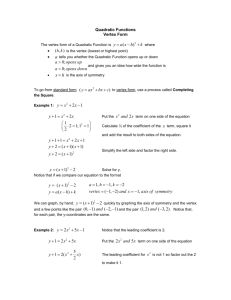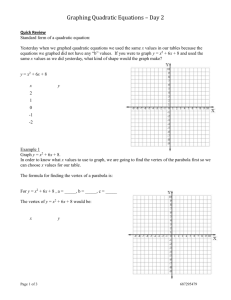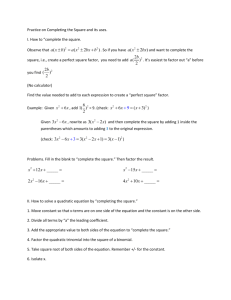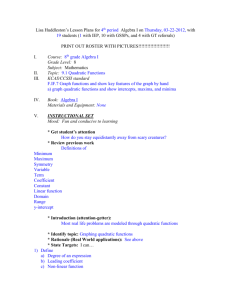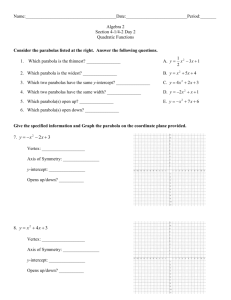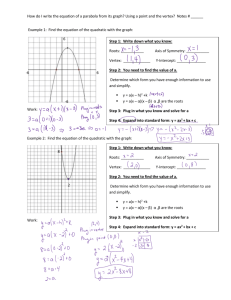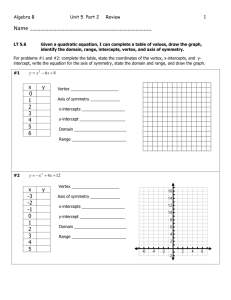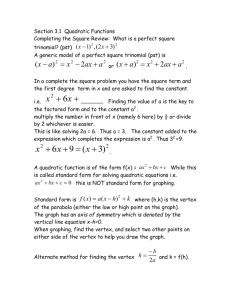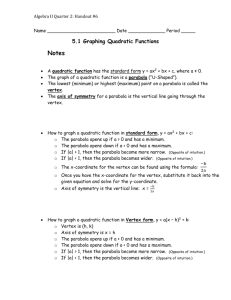Algebra 2 - School District 27J
advertisement
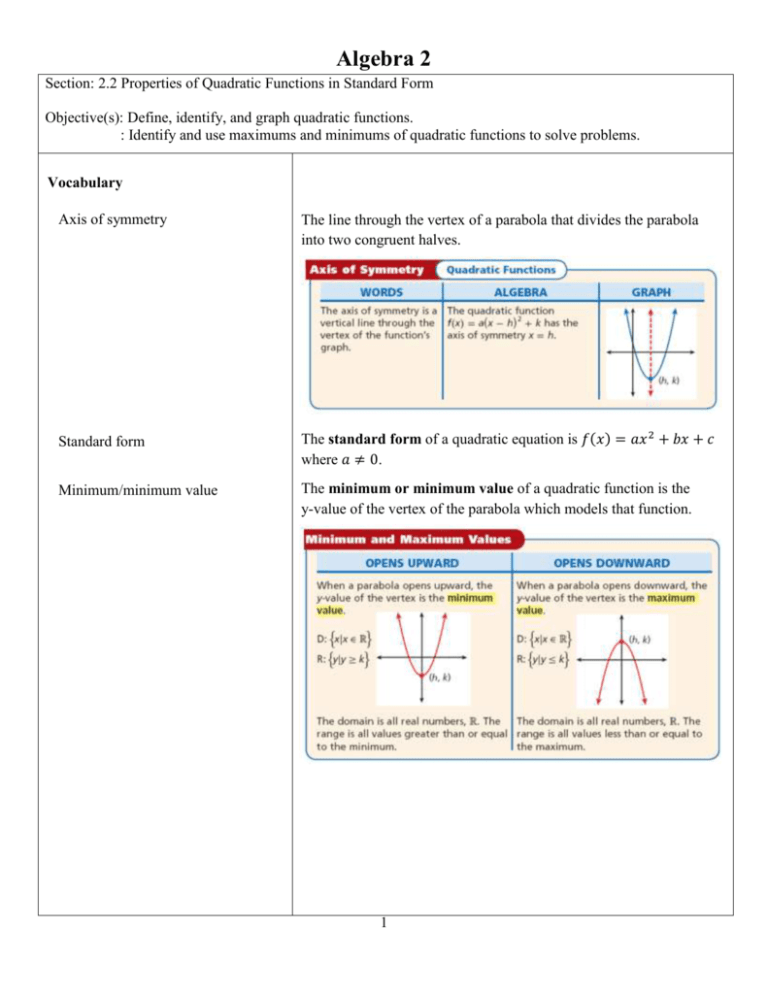
Algebra 2
Section: 2.2 Properties of Quadratic Functions in Standard Form
Objective(s): Define, identify, and graph quadratic functions.
: Identify and use maximums and minimums of quadratic functions to solve problems.
Vocabulary
Axis of symmetry
The line through the vertex of a parabola that divides the parabola
into two congruent halves.
Standard form
The standard form of a quadratic equation is 𝑓(𝑥) = 𝑎𝑥 2 + 𝑏𝑥 + 𝑐
where 𝑎 ≠ 0.
Minimum/minimum value
The minimum or minimum value of a quadratic function is the
y-value of the vertex of the parabola which models that function.
1
Algebra 2
Example 1 – Identify the axis of
symmetry for the graph of
1
𝑓(𝑥) = − 2 (𝑥 + 5)2 − 8
Example 2 – Identify the axis of
symmetry for the graph of
1
𝑓(𝑥) = − 2 (𝑥 + 5)2 − 8
2
Algebra 2
Consider the standard form of a
quadratic equation:
𝑓(𝑥) = 𝑎𝑥 2 + 𝑏𝑥 + 𝑐
The coefficients a, b, and c can show
properties of the graph of the
function. You can determine these
properties by expanding the vertex
form.
These properties can be generalized to
help you graph quadratic functions.
3
Algebra 2
Example 3 – Consider the function:
𝑓(𝑥) = 2𝑥 2 − 4𝑥 + 5
a) Determine whether the graph opens
upward or downward
Because the value of a is positive, the parabola opens upward.
b) Find the axis of symmetry (Note:
the axis of symmetry is ALWAYS an
equation.)
c) Find the vertex
d) Find the y-intercept
Because the value of c is 5, the y-intercept is 5
e) Graph the function
4
Algebra 2
Example 3: Consider the function:
𝑓(𝑥) = −𝑥 2 − 2𝑥 + 3
a) Determine whether the graph opens
upward or downward
Because the value of a is negative (-1), the parabola opens
upward.
b) Find the axis of symmetry (Note:
the axis of symmetry is ALWAYS an
equation.)
c) Find the vertex
d) Find the y-intercept
Because the value of c is 3, the y-intercept is 3
e) Graph the function
5
Algebra 2
Example 4: Consider the function:
𝑓(𝑥) = −2𝑥 2 − 4𝑥
a) Determine whether the graph
opens upward or downward
Because the value of a is negative (-1), the parabola opens
upward.
b) Find the axis of symmetry (Note:
the axis of symmetry is ALWAYS an
equation.)
c) Find the vertex
d) Find the y-intercept
e) Graph the function
6
Algebra 2
Example 5: Consider the function:
𝑓(𝑥) = 𝑥 2 + 3𝑥 − 1
a) Determine whether the graph
opens upward or downward
b) Find the axis of symmetry (Note:
the axis of symmetry is ALWAYS an
equation.)
c) Find the vertex
d) Find the y-intercept
e) Graph the function
7
Algebra 2
Domain and range of quadratic
functions
Substituting any real value of x into a quadratic equation results in a
real number. Therefore, the domain of any quadratic function is all
real numbers. The range of a quadratic function depends on its vertex
and the direction that the parabola opens.
Maximum and minimum values of
a quadratic functions
Example 6: Consider the function:
𝑓(𝑥) = −3𝑥 2 − 2𝑥 + 4
a) Find the maximum and minimum
values
8
Algebra 2
b) State the domain and range
The domain is the set of all real numbers, ℝ.
11
The range is the set of all real numbers less than or equal to − 3 ,
11
or {𝑦: 𝑦 ≤ − 3 }.
Example 7: Consider the function:
𝑓(𝑥) = 𝑥 2 − 6𝑥 + 3
a) Find the maximum and minimum
values
b) State the domain and range
The domain is the set of all real numbers, ℝ.
The range is the set of all real numbers less than or equal to −6,
or {𝑦: 𝑦 ≥ −6}.
9
Algebra 2
Example 8: Consider the function:
𝑓(𝑥) = −2𝑥 2 − 4
a) Find the maximum and minimum
values
b) State the domain and range
The domain is the set of all real numbers, ℝ.
The range is the set of all real numbers less than or equal to −4,
or {𝑦: 𝑦 ≥ −4}.
10
Algebra 2
Example 9: The average height h in
centimeters of a certain type of grain
can be modeled by the function
ℎ(𝑟) = 0.024𝑟 2 − 1.28𝑟 + 33.6
where r is the distance in centimeters
between the rows in which the grain
is planted. Based on this model, what
is the minimum average height of the
grain, and what is the row spacing
that results in this height?
11
Algebra 2
The highway mileage m in miles per
gallon for a compact car is
approximately by
𝑚(𝑠) = −0.025𝑠 2 + 2.45𝑠 − 30
where s is the speed in miles per hour.
What is the maximum mileage for this
compact car to the nearest tenth of a
mile per gallon? What speed results in
this mileage?
12
